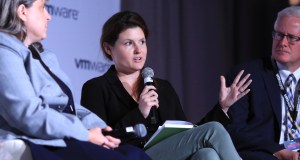Treasury’s Fiscal Service attempts to make blockchain more tangible in pilot

Depending on who you ask, blockchain may be described as “the most disruptive tech in decades,” “the internet grabbing its pitchfork,” a “radical” transformation of the status quo.
But understanding what the technology actually is can be challenging, as John Hill of the Office of Financial Innovation and Transformation at the Treasury’s Fiscal Service is well aware. That’s why, in a new pilot program, he’s trying to bring it down to earth.
His office is using blockchain (a complicated, hype-laden word many struggle to understand) to better track agency-owned physical assets like computers, phones and more (those simple, familiar items that everyone understands). The hope? The pilot will serve not only as a way to assess the usefulness of blockchain for this purpose, but also as an educational experience — a way to make a complex technology very “tangible.”
Currently, asset management is a manual-, spreadsheet- or even pen-and-paper-based process, focused on reconciling a physical asset with a description of its status. “Across the government there are hundreds, perhaps thousands, of property custodians who every quarter have to reconcile a master list of inventory against the physical, you know, entities that are on that inventory,” Hill said. “It’s a reconciliation process.”
“Blockchain,” meanwhile, “offers an entirely different paradigm for how you do a reconciliation process,” he said. The Fiscal Service, from its position in the financial sector, is involved in lots of reconciliation processes — this one just happens to be particularly straightforward.
It also accomplishes the goal of separating blockchain from cryptocurrency, another distinction Hill is careful to note.
The pilot launched in September 2017, Craig Fischer, a program manager, told FedScoop. “So what we wanted to see is can we use blockchain technology just to make this process much more efficient, transparent, giving real-time acknowledgement of where these assets are,” Fischer said. “This is not an attempt to change the way the Fiscal Service or other people do asset management. This was meant to be an education for us. We wanted to take this opportunity to educate people in a real palpable way.”
The project won’t wrap up until the end of February, so Hill and Fischer don’t have much insight yet into whether blockchain is the tool for asset management process, or just a tool. They’re tracking key metrics closely though — chief among them the efficiency that blockchain brings. In assessing the pilot, Hill said, the team is asking questions like: How many manual steps are replaced with the new system? And how does this balance against the cost associated with a blockchain solution?
“It is too early to tell” whether blockchain will have a big play in the federal government, Hill said. “But [it’s] certainly worthy of a very thoughtful, disciplined, rigorous evaluation.”
“This is a very complicated technology,” he went on. “It requires a level of investment to understand it and apply it even in this narrow proof of concept. You don’t do this on the fly, you don’t do it quickly. It takes a very thoughtful, deliberative approach.”
Fischer agrees that it’s too early to make any pronouncement of future value. But on a hopeful note, he adds, “at this point in our very narrow proof-of-concept there haven’t been any ‘showstoppers.'”






